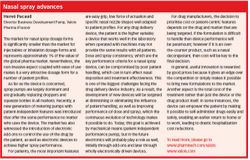A new generation of transdermal delivery
Pharmaceutical Technology Europe
Transdermal drug delivery is valued by patients and physicians for the comfort and convenience it offers — no needles, no pills and ease of use
Transdermal drug delivery is valued by patients and physicians for the comfort and convenience it offers — no needles, no pills and ease of use. For some drugs, transdermal delivery offers therapeutic benefits. Many vaccines, for example, when delivered to the skin, produce a more robust immune response quicker than when the same vaccine is administered by injection.
Transdermal drug delivery technology has traditionally been associated with a number of challenges that have restricted its use, for example: inefficiency in drug dose delivered; poor efficacy; inability to delivery water-soluble compounds; and skin irritation.
We have worked to develop a transdermal delivery system that has been shown to successfully deliver therapeutics across a broad range of doses and therapy types. I believe such innovations could see transdermal delivery replace injectable delivery in many cases, particularly as biopharmaceutical pipelines mature and the next generation of innovative therapies begin to make their way onto the marketplace.
Microstructured transdermal system technology
Our solid microstructured transdermal system (sMTS) is built around a polymeric microstructured array — a manufacturable delivery component that provides safe and efficient drug delivery to the skin. Arrays can be moulded to comprise one to approximately 1300 microstructures — each 150–900 µm tall and with a wide variety of shapes. The drug or vaccine is coated reproducibly just on the tips of the microstructures and is rapidly delivered into the skin once the array is applied; application is painless and the wear time is low. The dosing range for sMTS is 0.1–500 µg and therapeutic payload can be typically delivered in 30 s–15 min. Because the drug or vaccine is only on the tips of the microstructures, sMTS usually delivers 85–99% of the coated drug, which makes the system very efficient.
For our sMTS, we currently have a wearable, disposable device for singleuse self application and a device that is built around an external applicator that leaves a small patch on the skin, which the patient can remove and dispose of after use.
Traditional drug in adhesive transdermal technologies are not designed to deliver watersoluble compounds, but by piercing the stratum corneum with MTS we can greatly expand the classes of molecules that can be delivered through the skin — proteins, peptides and small molecule salts. This versatility really changes the landscape with respect to delivery options pharmaceutical companies can consider — particularly for therapeutics that have typically been restricted to delivery by syringe injection.
MTS is simple and non-intimidating, which is what patients expect for transdermal delivery, but the system can also offer the efficiency and versatility of delivery at a level more commonly associated with a syringe injection. That efficiency is particularly important in biopharmaceutical markets where the API production process leads to higher priced therapeutics.
In the pipeline
The company is also developing a hollow microstructured transdermal system (hMTS), which uses a polymeric array that comprises very small hypodermic needles (< 1 mm). Instead of delivering a drug coated on the array, these tiny structures provide fluid communication through the array into the intradermal space, thus enabling the delivery of liquid formulations. Intradermal delivery of liquid formulations is typically limited to about 100 µL, but with hMTS, that capacity can be increased to 1–1.5 mL.
The future of transdermals
It's a very exciting time for transdermal drug delivery. As more biopharmaceutical products are developed, the demand for needlefree injection systems will grow. Pharmaceutical companies need to find ways to differentiate their products; physicians want to see products that increase compliance and keep patients away from the clinic; and patients want convenient and painless administration. With the advent of transdermal systems, transdermal drug delivery is in the best position to meet these growing demands across the board.
Couple these needs with the growing imperative to more effectively and efficiently vaccinate large populations quickly (in the face of a flu pandemic or a homeland security crisis, for example) and transdermal drug delivery with an efficient transdermal delivery system becomes the obvious choice, in my opinion, for now and for the future.




